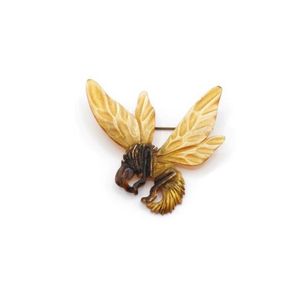Art Nouveau Horn Bee Brooch
Art Nouveau period bee brooch size 64 mm x 66 mm, likely carved horn
You must be a subscriber, and be logged in to view price and dealer details.
Subscribe Now to view actual auction price for this item
When you subscribe, you have the option of setting the currency in which to display prices to $Au, $US, $NZ or Stg.
This item has been sold, and the description, image and price are for reference purposes only.
- Bee Motif - The bee is a popular motif in jewellery design, often used to symbolize industry, hard work, and the natural world. They can be depicted in a variety of styles, from realistic to stylized, and are often used as a decorative element on rings, pendants, earrings, and other types of jewellery. In many cultures, bees are also seen as a symbol of prosperity and good luck, making them a popular choice for talismanic jewellery. Some people also choose to wear bee-themed jewellery as a way to show support for the conservation of bees, which are important pollinators that play a vital role in the health of ecosystems around the world.
- Art Nouveau Period - The Art Nouveau period was a cultural movement that emerged in the late 19th century, and was characterized by its emphasis on natural forms, flowing lines, and a decorative, ornamental style. Art Nouveau was a reaction against the ornate and heavily stylized designs of the previous era, and sought to create a new, more organic aesthetic.
Art Nouveau was characterized by its use of sinuous, curving lines, as well as a focus on natural elements such as flowers, vines, and other organic shapes. Art Nouveau designers sought to create a total work of art, in which every element of a building or object was designed to be harmonious with the overall design.
Some of the most iconic examples of Art Nouveau design include the Paris Metro entrances designed by Hector Guimard, the works of the artist Alphonse Mucha, and the architecture of Victor Horta in Brussels.
The Art Nouveau period was at its peak between 1890 and 1910, but began to decline in popularity by the start of World War I. However, Art Nouveau remains an important influence on design and art to this day, and continues to be celebrated for its emphasis on natural forms and decorative style.
This item has been included into following indexes:
